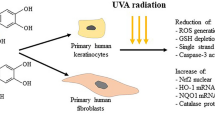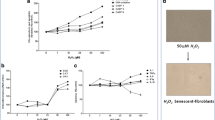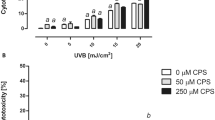Abstract
Benzene is volatile organic hydrocarbon which is widely used in a wide range of industries. Studies have shown that exposure to benzene consequences serious health risks for human. Understanding the effect and risks of environmental hazard materials in the laser therapy of skin is interesting which can show useful or harmful role of these effects in therapies. In this study, the effect of low-level laser therapy was investigated on benzene-induced cytotoxicity on human skin fibroblast cells (HU02). Human skin fibroblast cells (HU02) were exposed to various concentrations of benzene (0–100 μg/mL) and incubated for 2 h. Then the effect of low-level laser therapy (LLLT) at 660-nm wavelength with 3 J/cm2 energy for 90 s was investigated on the viability of the cells exposed to benzene using MTT assay and inverted light microscope. The effect of low-level laser therapy on the viability of the cells was positive at concentrations 0–15 μg/mL but negative at higher concentrations than 15 μg/mL. Low-level laser therapy in low concentrations of benzene decreases the cytotoxicity caused by benzene and maintains cell viability. At high concentrations and in the presence of low-level laser therapy, the cell viability decreased compared to dark experiment. The morphology study of the cells using inverted light microscopy has confirmed the MTT results.




Similar content being viewed by others
References
Grigoryan H, Edmands WMB, Lan Q, et al (2018) Adductomic signatures of benzene exposure provide insights into cancer induction 39:661–668 . doi: https://doi.org/10.1093/carcin/bgy042
Cocchieri RA, Arnese A, Minicucci AM (1990) Polycyclic aromatic hydrocarbons in marine organisms from Italian Central Mediterranean coasts. Mar Pollut Bull 21:15–18. https://doi.org/10.1016/0025-326X(90)90146-Y
Bernstein JA, Alexis N, Bacchus H et al (2008) The health effects of nonindustrial indoor air pollution. J Allergy Clin Immunol 121:585–591. https://doi.org/10.1016/j.jaci.2007.10.045
Falzone L, Marconi A, Loreto C et al (2016) Occupational exposure to carcinogens: benzene, pesticides and fibers. Mol Med Rep 14:4467–4474. https://doi.org/10.3892/mmr.2016.5791
Andrews LS, Lee EW, Witmer CM et al (1977) Effects of toluene on the metabolism, disposition and hemopoietic toxicity of [3H]benzene. Biochem Pharmacol 26:293–300. https://doi.org/10.1016/0006-2952(77)90180-0
Bolcsak LE, Nerland DE (1983) Inhibition of erythropoiesis by benzene and benzene metabolites. Toxicol Appl Pharmacol 69:363–368. https://doi.org/10.1016/0041-008X(83)90259-4
Arnold SM, Angerer J, Boogaard PJ et al (2013) The use of biomonitoring data in exposure and human health risk assessment: benzene case study. Crit Rev Toxicol 43:119–153. https://doi.org/10.3109/10408444.2012.756455
BRIEF RS, LYNCHA J, BERNATH T, SCALA RA (1980) Benzene in the workplace. Am Ind Hyg Assoc J 41:616–623. https://doi.org/10.1080/15298668091425392
Pajaro-Castro N, Caballero-Gallardo K, Olivero-Verbel J (2017) Toxicity of naphthalene and benzene on Tribollium castaneum Herbst. Int J Environ Res Public Health 14:667. https://doi.org/10.3390/ijerph14060667
Hosseinzadeh R, Moosavi Movahedi AA, Ghourchian H (2008) New insight on biological interaction analysis: new nanocrystalline mixed metal oxide SPME fiber for GC-FID analysis of BTEX and its application in human hemoglobin-benzene interaction studies. PLoS One 9:308–318. https://doi.org/10.1371/journal.pone.0102992
Hosseinzadeh R, Moosavi-Movahedi AA, Ghourchian H (2014) Electrochemistry and molecular modeling of the hemoglobin–benzene interaction with a nanocrystalline mixed metal oxide. RSC Adv 4:49128–49136. https://doi.org/10.1039/C4RA08018A
Hosseinzadeh R, Moosavi-Movahedi AA (2016) Human hemoglobin structural and functional alterations and heme degradation upon interaction with benzene: a spectroscopic study. Spectrochim Acta - Part A Mol Biomol Spectrosc 157. https://doi.org/10.1016/j.saa.2015.12.014
McHale CM, Zhang L, Lan Q et al (2011) Global gene expression profiling of a population exposed to a range of benzene levels. Environ Health Perspect 119:628–640. https://doi.org/10.1289/ehp.1002546
Carrieri M, Pigini D, Martinelli A et al (2019) Effect of benzene exposure on the urinary biomarkers of nucleic acid oxidation in two cohorts of gasoline pump attendants. Int J Environ Res Public Health 16:129. https://doi.org/10.3390/ijerph16010129
Cardoso Bezerra SJ, Fioranelli Vieira G, Eduardo C de P et al (2015) Laser phototherapy (660 nm) can be beneficial for reducing gingival inflammation in prosthodontics. Case Rep Dent 2015:1–6. https://doi.org/10.1155/2015/132656
Morsoleto MJM da, S, Sella V, Machado P, et al (2019) Effect of low power laser in biomodulation of cultured osteoblastic cells of Wistar rats Acta Cir Bras 34: . doi: https://doi.org/10.1590/s0102-8650201900210
Karu TI, Pyatibrat LV, Afanasyeva NI (2005) Cellular effects of low power laser therapy can be mediated by nitric oxide. Lasers Surg Med 36:307–314. https://doi.org/10.1002/lsm.20148
Huang Y-Y, Chen AC-H, Carroll JD, Hamblin MR (2009) Biphasic dose response in low level light therapy. Dose-Response 7:358–383. https://doi.org/10.2203/dose-response.09-027.Hamblin
Antunes F, Boveris A, Cadenas E (2004) On the mechanism and biology of cytochrome oxidase inhibition by nitric oxide. Proc Natl Acad Sci 101:16774–16779. https://doi.org/10.1073/pnas.0405368101
Fenga C, Gangemi S, Teodoro M et al (2017) 8-Hydroxydeoxyguanosine as a biomarker of oxidative DNA damage in workers exposed to low-dose benzene. Toxicol Rep 4:291–295. https://doi.org/10.1016/j.toxrep.2017.05.008
Wang D, Yang X, Zhang Y et al (2018) Platelet mitochondrial cytochrome c oxidase subunit I variants with benzene poisoning. J Thorac Dis 10:6811–6818. https://doi.org/10.21037/jtd.2018.11.82
WIERDA KGAD (1984) In vitro effects of benzene metabolites on mouse bone marrow stromal cells. Toxicol Appl Pharmacol 76:45–55
McHale CM, Zhang L, Smith MT (2012) Current understanding of the mechanism of benzene-induced leukemia in humans: implications for risk assessment. Carcinogenesis 33:240–252. https://doi.org/10.1093/carcin/bgr297
Snyder R, Hedli CC (1996) An overview of benzene metabolism. Environ Health Perspect 104:1165–1171. https://doi.org/10.1289/ehp.961041165
He L, He T, Farrar S et al (2017) Antioxidants maintain cellular redox homeostasis by elimination of reactive oxygen species. Cell Physiol Biochem 44:532–553. https://doi.org/10.1159/000485089
Huang Y-Y, Nagata K, Tedford CE et al (2012) Low-level laser therapy (LLLT) reduces oxidative stress in primary cortical neurons in vitro. J Biophotonics n/a-n/a. https://doi.org/10.1002/jbio.201200157
Kumar Rajendran N, George BP, Chandran R et al (2019) The influence of light on reactive oxygen species and NF-кB in disease progression. Antioxidants 8:640. https://doi.org/10.3390/antiox8120640
Acknowledgments
The authors gratefully acknowledge all the people who helped us do this project.
Author information
Authors and Affiliations
Corresponding authors
Ethics declarations
Competing interests
The authors declare that they have no conflict of interest.
Additional information
Publisher’s note
Springer Nature remains neutral with regard to jurisdictional claims in published maps and institutional affiliations.
Rights and permissions
About this article
Cite this article
Salemi, M., Khorsandi, K., Hosseinzadeh, R. et al. Effect of low-level laser irradiation on cytotoxicity of benzene in human normal fibroblast cells. Lasers Med Sci 36, 1831–1836 (2021). https://doi.org/10.1007/s10103-020-03211-y
Received:
Accepted:
Published:
Issue Date:
DOI: https://doi.org/10.1007/s10103-020-03211-y




